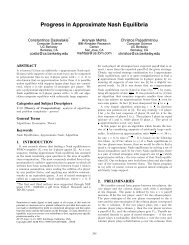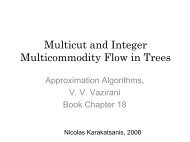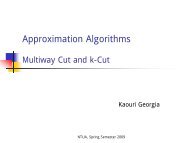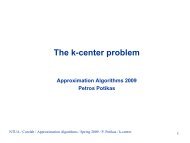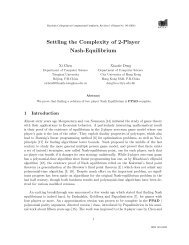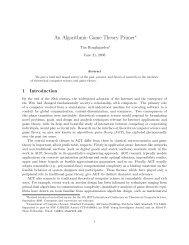The Polynomial Hierarchy - Corelab
The Polynomial Hierarchy - Corelab
The Polynomial Hierarchy - Corelab
Create successful ePaper yourself
Turn your PDF publications into a flip-book with our unique Google optimized e-Paper software.
<strong>The</strong><strong>Polynomial</strong><strong>Hierarchy</strong>A.AntonopoulosOutlineOptimizationProblemsIntroduction<strong>The</strong> Class DPOracle Classes<strong>The</strong><strong>Polynomial</strong><strong>Hierarchy</strong>DefinitionBasic <strong>The</strong>oremsBPP and PH<strong>The</strong> <strong>Polynomial</strong> <strong>Hierarchy</strong>A.Antonopoulos18/1/2010
<strong>The</strong><strong>Polynomial</strong><strong>Hierarchy</strong>A.AntonopoulosOutlineOptimizationProblemsIntroduction<strong>The</strong> Class DPOracle Classes<strong>The</strong><strong>Polynomial</strong><strong>Hierarchy</strong>DefinitionBasic <strong>The</strong>oremsBPP and PH1 Optimization ProblemsIntroduction<strong>The</strong> Class DPOracle Classes2 <strong>The</strong> <strong>Polynomial</strong> <strong>Hierarchy</strong>DefinitionBasic <strong>The</strong>oremsBPP and PH
DP Class Definition<strong>The</strong><strong>Polynomial</strong><strong>Hierarchy</strong>A.AntonopoulosOutlineOptimizationProblemsIntroduction<strong>The</strong> Class DPOracle Classes<strong>The</strong><strong>Polynomial</strong><strong>Hierarchy</strong>DefinitionBasic <strong>The</strong>oremsBPP and PHDefinitionA language L is in the class DP if and only if there are twolanguages L 1 ∈ NP and L 2 ∈ coNP such that L = L 1 ∩ L 2 .DP is not NP ∩ coNP!Also, DP is a syntactic class, and so it has completeproblems.
Complete Problems for DP<strong>The</strong><strong>Polynomial</strong><strong>Hierarchy</strong>A.AntonopoulosOutlineOptimizationProblemsIntroduction<strong>The</strong> Class DPOracle Classes<strong>The</strong><strong>Polynomial</strong><strong>Hierarchy</strong>DefinitionBasic <strong>The</strong>oremsBPP and PH
Complete Problems for DP<strong>The</strong><strong>Polynomial</strong><strong>Hierarchy</strong>A.Antonopoulos<strong>The</strong>oremSAT-UNSAT is DP-complete.OutlineOptimizationProblemsIntroduction<strong>The</strong> Class DPOracle Classes<strong>The</strong><strong>Polynomial</strong><strong>Hierarchy</strong>DefinitionBasic <strong>The</strong>oremsBPP and PH
Complete Problems for DP<strong>The</strong><strong>Polynomial</strong><strong>Hierarchy</strong>A.AntonopoulosOutlineOptimizationProblemsIntroduction<strong>The</strong> Class DPOracle Classes<strong>The</strong><strong>Polynomial</strong><strong>Hierarchy</strong>DefinitionBasic <strong>The</strong>oremsBPP and PH<strong>The</strong>oremSAT-UNSAT is DP-complete.ProofFirstly, we have to show it is in DP.So, let:L 1 ={(φ, φ ′ ): φ is satisfiable}.L 2 ={(φ, φ ′ ): φ ′ is unsatisfiable}.It is easy to see, L 1 ∈ NP and L 2 ∈ coNP, thusL ≡ L 1 ∩ L 2 ∈ DP.For completeness, let L ∈ DP. We have to show thatL ≤ P SAT-UNSAT. L ∈ DP ⇒ L = L 1 ∩ L 2 , L 1 ∈ NP andL 2 ∈ coNP.SAT NP-complete⇒ ∃R 1 :L 1 ≤ P SAT and R 2 :L 2 ≤ P SAT.Hence, L ≤ P SAT-UNSAT,by R(x) = (R 1 (x), R 2 (x))
Complete Problems for DP<strong>The</strong><strong>Polynomial</strong><strong>Hierarchy</strong>A.AntonopoulosOutlineOptimizationProblemsIntroduction<strong>The</strong> Class DPOracle Classes<strong>The</strong><strong>Polynomial</strong><strong>Hierarchy</strong>DefinitionBasic <strong>The</strong>oremsBPP and PH<strong>The</strong>oremEXACT TSP is DP-complete.ProofEXACT TSP ∈ DP, by L 1 ≡TSP ∈ NP and L 2 ≡TSPCOMPLEMENT ∈ coNPCompleteness: we’ll show that SAT-UNSAT≤ P EXACTTSP.3SAT≤ P HP: (φ, φ ′ ) → (G, G ′ )Broken Hamilton Path (2 node-disjoint paths that coverall nodes)Almost Satisfying Truth Assignement (satisfies all clausesexcept for one)
Complete Problems for DP<strong>The</strong><strong>Polynomial</strong><strong>Hierarchy</strong>A.AntonopoulosOutlineOptimizationProblemsIntroduction<strong>The</strong> Class DPOracle Classes<strong>The</strong><strong>Polynomial</strong><strong>Hierarchy</strong>DefinitionBasic <strong>The</strong>oremsBPP and PHProofWe define distances:1 If (i, j) ∈ E(G) or E(G’): d(i, j) ≡ 12 If (i, j) /∈ E(G), but i and j ∈ V(G): d(i, j) ≡ 23 Otherwise: d(i, j) ≡ 4Let n be the size of the graph.1 If φ and φ ′ satisfiable, then optCost = n2 If φ and φ ′ unsatisfiable, then optCost = n + 33 If φ satisfiable and φ ′ not, then optCost = n + 24 If φ ′ satisfiable and φ not, then optCost = n + 1“yes” instance of SAT-UNSAT ⇔ optCost = n + 2Let B ≡ n + 2!
Other DP-complete problems<strong>The</strong><strong>Polynomial</strong><strong>Hierarchy</strong>A.AntonopoulosOutlineOptimizationProblemsIntroduction<strong>The</strong> Class DPOracle Classes<strong>The</strong><strong>Polynomial</strong><strong>Hierarchy</strong>DefinitionBasic <strong>The</strong>oremsBPP and PHAlso:CRITICAL SAT: Given a Boolean expression φ, is it truethat it’s unsatisfiable, but deleting any clause makes itsatisfiable?CRITICAL HAMILTON PATH: Given a graph, is it truethat it has no Hamilton path, but addition of any edgecreates a Hamilton path?CRITICAL 3-COLORABILITY: Given a graph, is it truethat it is not 3-colorable, but deletion of any node makesit 3-colorable?are DP-complete!
<strong>The</strong> Classes P NP and FP NP<strong>The</strong><strong>Polynomial</strong><strong>Hierarchy</strong>A.AntonopoulosOutlineOptimizationProblemsIntroduction<strong>The</strong> Class DPOracle Classes<strong>The</strong><strong>Polynomial</strong><strong>Hierarchy</strong>DefinitionBasic <strong>The</strong>oremsBPP and PHAlternative DP DefinitionDP is the class of languages that can be decided by an oraclemachine which makes 2 queries to a SAT oracle, and accepts iffthe 1st answer is yes, and the 2nd is no.P SAT is the class of languages decided in pol time with aSAT oracle.<strong>Polynomial</strong> number of queriesQueries computed adaptivelySAT NP-complete ⇒ P SAT =P NPFP NP is the class of functions that can be computed by apol-time TM with a SAT oracle.Goal: MAX OUTPUT≤ P MAX-WEIGHT SAT≤ P SAT
FP NP -complete Problems<strong>The</strong><strong>Polynomial</strong><strong>Hierarchy</strong>A.AntonopoulosOutlineOptimizationProblemsIntroduction<strong>The</strong> Class DPOracle Classes<strong>The</strong><strong>Polynomial</strong><strong>Hierarchy</strong>DefinitionBasic <strong>The</strong>oremsBPP and PHMAX OUTPUT DefinitionGiven NTM N, with input 1 n , which halts after O(n),withoutput a string of length n. Which is the largest output,of anycomputation of N on 1 n ?
FP NP -complete Problems<strong>The</strong><strong>Polynomial</strong><strong>Hierarchy</strong>A.AntonopoulosOutlineOptimizationProblemsIntroduction<strong>The</strong> Class DPOracle Classes<strong>The</strong><strong>Polynomial</strong><strong>Hierarchy</strong>DefinitionBasic <strong>The</strong>oremsBPP and PHMAX OUTPUT DefinitionGiven NTM N, with input 1 n , which halts after O(n),withoutput a string of length n. Which is the largest output,of anycomputation of N on 1 n ?<strong>The</strong>oremMAX OUTPUT is FP NP -complete.ProofMAX OUTPUT ∈ FP NP .Let F : Σ ∗ → Σ ∗ ∈ FP NP ⇒ ∃ pol-time TM M ? , s.t.M SAT (x) = F (x)We’ll show: F ≤MAX OUTPUT!Reductions R and S (log space computable) s.t.:∀x, R(x) is a instance of MAX OUTPUTS(max output of R(x)) → F (x)
FP NP -complete Problems<strong>The</strong><strong>Polynomial</strong><strong>Hierarchy</strong>A.AntonopoulosOutlineOptimizationProblemsIntroduction<strong>The</strong> Class DPOracle Classes<strong>The</strong><strong>Polynomial</strong><strong>Hierarchy</strong>DefinitionBasic <strong>The</strong>oremsBPP and PHProofNTM N:Let n = p 2 (|x|), p(· ), is the pol bound of SAT.N(1 n ) generates x on a string.M SAT query state (φ 1 ):If z 1 = 0 (φ 1 unsat), then continue from q NO .If z 1 = 1 (φ 1 sat), then guess assignment T 1 :If test succeeds, continue from q YES .If test fails, output=0 n and halt. (Unsuccessfulcomputation)Continue to all guesses (z i ), and halt, with output= z 1 z 2 ....00} {{ }n(Successful computation)
FP NP -complete Problems<strong>The</strong><strong>Polynomial</strong><strong>Hierarchy</strong>A.AntonopoulosOutlineOptimizationProblemsIntroduction<strong>The</strong> Class DPOracle Classes<strong>The</strong><strong>Polynomial</strong><strong>Hierarchy</strong>DefinitionBasic <strong>The</strong>oremsBPP and PHProofWe claim that the successful computation that outputs thelargest integer, correspond to a correct simulation:Let j the smallest integer,s.t.: z j = 0, while φ j was satisfiable.<strong>The</strong>n, ∃ another successful computation of N, s.t.: z j = 1.<strong>The</strong> computations agree to the first j − 1 digits,⇒ the 2 ndrepresents a larger number.<strong>The</strong> S part: F (x) can be read off the end of the largest outputof N.
FP NP -complete Problems<strong>The</strong><strong>Polynomial</strong><strong>Hierarchy</strong>A.AntonopoulosOutlineOptimizationProblemsIntroduction<strong>The</strong> Class DPOracle Classes<strong>The</strong><strong>Polynomial</strong><strong>Hierarchy</strong>DefinitionBasic <strong>The</strong>oremsBPP and PHMAX-WEIGHT SAT DefinitionGiven a set of clauses, each with an integer weight, find thetruth assignment that satisfies a set of clauses with the mosttotal weight.
FP NP -complete Problems<strong>The</strong><strong>Polynomial</strong><strong>Hierarchy</strong>A.AntonopoulosOutlineOptimizationProblemsIntroduction<strong>The</strong> Class DPOracle Classes<strong>The</strong><strong>Polynomial</strong><strong>Hierarchy</strong>DefinitionBasic <strong>The</strong>oremsBPP and PHMAX-WEIGHT SAT DefinitionGiven a set of clauses, each with an integer weight, find thetruth assignment that satisfies a set of clauses with the mosttotal weight.<strong>The</strong>oremMAX-WEIGHT SAT is FP NP -complete.ProofMAX-WEIGHT SAT is in FP NP : By binary search, and a SAToracle, we can find the largest possible total weight of satisfiedclauses, and then, by setting the variables 1-1, the truthassignment that achieves it.MAX OUTPUT≤MAX-WEIGHT SAT:
FP NP -complete Problems<strong>The</strong><strong>Polynomial</strong><strong>Hierarchy</strong>A.AntonopoulosOutlineOptimizationProblemsIntroduction<strong>The</strong> Class DPOracle Classes<strong>The</strong><strong>Polynomial</strong><strong>Hierarchy</strong>DefinitionBasic <strong>The</strong>oremsBPP and PHProofNTMN(1 n ) → φ(N, m):Any satisfying truth assignment of φ(N, m) → legal comp.of N(1 n )Clauses are given a huge weight (2 n ), so that any t.a. thataspires to be optimum satisfy all clauses of φ(N, m).Add more clauses: (y i ): i = 1, ..n with weight 2 n−i .Now, optimum t.a. must not represent any legalcomputation, but this which produces the largest possibleoutput value.S part: From optimum t.a. of the resulting expression (orthe weight), we can recover the optimum output of N(1 n ).
FP NP -complete Problems<strong>The</strong><strong>Polynomial</strong><strong>Hierarchy</strong>A.AntonopoulosOutlineOptimizationProblemsIntroduction<strong>The</strong> Class DPOracle Classes<strong>The</strong><strong>Polynomial</strong><strong>Hierarchy</strong>DefinitionBasic <strong>The</strong>oremsBPP and PHAnd the main result:<strong>The</strong>oremTSP is FP NP -complete.
FP NP -complete Problems<strong>The</strong><strong>Polynomial</strong><strong>Hierarchy</strong>A.AntonopoulosOutlineOptimizationProblemsIntroduction<strong>The</strong> Class DPOracle Classes<strong>The</strong><strong>Polynomial</strong><strong>Hierarchy</strong>DefinitionBasic <strong>The</strong>oremsBPP and PHAnd the main result:<strong>The</strong>oremTSP is FP NP -complete.CorollaryTSP COST is FP NP -complete.
FP NP -complete Problems<strong>The</strong><strong>Polynomial</strong><strong>Hierarchy</strong>A.AntonopoulosOutlineOptimizationProblemsIntroduction<strong>The</strong> Class DPOracle Classes<strong>The</strong><strong>Polynomial</strong><strong>Hierarchy</strong>DefinitionBasic <strong>The</strong>oremsBPP and PHFigure: <strong>The</strong> overall construction (17-2)
NP[log n]<strong>The</strong> Class P<strong>The</strong><strong>Polynomial</strong><strong>Hierarchy</strong>A.AntonopoulosOutlineOptimizationProblemsIntroduction<strong>The</strong> Class DPOracle Classes<strong>The</strong><strong>Polynomial</strong><strong>Hierarchy</strong>DefinitionBasic <strong>The</strong>oremsBPP and PHDefinitionP NP[logn] is the class of all languages decided by a polynomialtime oracle machine, which on input x asks a total ofO(log |x|) SAT queries.FP NP[logn] is the corresponding class of functions.
NP[log n]<strong>The</strong> Class P<strong>The</strong><strong>Polynomial</strong><strong>Hierarchy</strong>A.AntonopoulosOutlineOptimizationProblemsIntroduction<strong>The</strong> Class DPOracle Classes<strong>The</strong><strong>Polynomial</strong><strong>Hierarchy</strong>DefinitionBasic <strong>The</strong>oremsBPP and PHDefinitionP NP[logn] is the class of all languages decided by a polynomialtime oracle machine, which on input x asks a total ofO(log |x|) SAT queries.FP NP[logn] is the corresponding class of functions.CLIQUE SIZE DefinitionGiven a graph, determine the size of his largest clique.
NP[log n]<strong>The</strong> Class P<strong>The</strong><strong>Polynomial</strong><strong>Hierarchy</strong>A.AntonopoulosOutlineOptimizationProblemsIntroduction<strong>The</strong> Class DPOracle Classes<strong>The</strong><strong>Polynomial</strong><strong>Hierarchy</strong>DefinitionBasic <strong>The</strong>oremsBPP and PHDefinitionP NP[logn] is the class of all languages decided by a polynomialtime oracle machine, which on input x asks a total ofO(log |x|) SAT queries.FP NP[logn] is the corresponding class of functions.CLIQUE SIZE DefinitionGiven a graph, determine the size of his largest clique.<strong>The</strong>oremCLIQUE SIZE is FP NP[logn] -complete.
Conclusion<strong>The</strong><strong>Polynomial</strong><strong>Hierarchy</strong>A.AntonopoulosOutlineOptimizationProblemsIntroduction<strong>The</strong> Class DPOracle Classes<strong>The</strong><strong>Polynomial</strong><strong>Hierarchy</strong>DefinitionBasic <strong>The</strong>oremsBPP and PH1 TSP (D) is NP-complete.2 EXACT TSP is DP-complete.3 TSP COST is FP NP -complete.4 TSP is FP NP -complete.And now,P NP → NP NP ?Oracles for NP NP ?
Outline<strong>The</strong><strong>Polynomial</strong><strong>Hierarchy</strong>A.AntonopoulosOutlineOptimizationProblemsIntroduction<strong>The</strong> Class DPOracle Classes<strong>The</strong><strong>Polynomial</strong><strong>Hierarchy</strong>DefinitionBasic <strong>The</strong>oremsBPP and PH1 Optimization ProblemsIntroduction<strong>The</strong> Class DPOracle Classes2 <strong>The</strong> <strong>Polynomial</strong> <strong>Hierarchy</strong>DefinitionBasic <strong>The</strong>oremsBPP and PH
<strong>The</strong> <strong>Polynomial</strong> <strong>Hierarchy</strong><strong>The</strong><strong>Polynomial</strong><strong>Hierarchy</strong>A.AntonopoulosOutlineOptimizationProblemsIntroduction<strong>The</strong> Class DPOracle Classes<strong>The</strong><strong>Polynomial</strong><strong>Hierarchy</strong>DefinitionBasic <strong>The</strong>oremsBPP and PH<strong>Polynomial</strong> <strong>Hierarchy</strong> Definition∆ 0 P = Σ 0 P = Π 0 P = P∆ i+1 P = P Σ i PΣ i+1 P = NP Σ i PΠ i+1 P = coNP Σ i PPH ≡ ⋃ i0Σ i P
<strong>The</strong> <strong>Polynomial</strong> <strong>Hierarchy</strong><strong>The</strong><strong>Polynomial</strong><strong>Hierarchy</strong>A.AntonopoulosOutlineOptimizationProblemsIntroduction<strong>The</strong> Class DPOracle Classes<strong>The</strong><strong>Polynomial</strong><strong>Hierarchy</strong>DefinitionBasic <strong>The</strong>oremsBPP and PH<strong>Polynomial</strong> <strong>Hierarchy</strong> Definition∆ 0 P = Σ 0 P = Π 0 P = P∆ i+1 P = P Σ i PΣ i+1 P = NP Σ i PΠ i+1 P = coNP Σ i PPH ≡ ⋃ i0Σ i P
<strong>The</strong> <strong>Polynomial</strong> <strong>Hierarchy</strong><strong>The</strong><strong>Polynomial</strong><strong>Hierarchy</strong>A.AntonopoulosOutlineOptimizationProblemsIntroduction<strong>The</strong> Class DPOracle Classes<strong>The</strong><strong>Polynomial</strong><strong>Hierarchy</strong>DefinitionBasic <strong>The</strong>oremsBPP and PH<strong>Polynomial</strong> <strong>Hierarchy</strong> Definition∆ 0 P = Σ 0 P = Π 0 P = P∆ i+1 P = P Σ i PΣ i+1 P = NP Σ i PΠ i+1 P = coNP Σ i PPH ≡ ⋃ i0Σ i PΣ 0 P = P∆ 1 P = P , Σ 1 P = NP , Π 1 P = coNP∆ 2 P = P NP , Σ 2 P = NP NP , Π 2 P = coNP NP
Basic <strong>The</strong>orems<strong>The</strong><strong>Polynomial</strong><strong>Hierarchy</strong>A.AntonopoulosOutlineOptimizationProblemsIntroduction<strong>The</strong> Class DPOracle Classes<strong>The</strong><strong>Polynomial</strong><strong>Hierarchy</strong>DefinitionBasic <strong>The</strong>oremsBPP and PH<strong>The</strong>oremLet L be a language , and i ≥ 1. L ∈ Σ i P iff there is apolynomially balanced relation R such that the language{x; y : (x, y) ∈ R} is in Π i−1 P andProof (by Induction)L = {x : ∃y, s.t. : (x, y) ∈ R}For i = 1{x; y : (x, y) ∈ R} ∈ P,so L = {x|∃y : (x, y) ∈ R} ∈ NPFor i > 1If ∃R ∈ Π i−1 P, we must show that L ∈ Σ i P ⇒∃ NTM with Σ i−1 P oracle: NTM(x) guesses a y and asksΣ i−1 P oracle whether (x, y) /∈ R.
Basic <strong>The</strong>orems<strong>The</strong><strong>Polynomial</strong><strong>Hierarchy</strong>A.AntonopoulosOutlineOptimizationProblemsIntroduction<strong>The</strong> Class DPOracle Classes<strong>The</strong><strong>Polynomial</strong><strong>Hierarchy</strong>DefinitionBasic <strong>The</strong>oremsBPP and PHProofIf L ∈ Σ i P, we must show the existence or R.L ∈ Σ i P ⇒ ∃ NTM M K , K ∈ Σ i−1 P, which decides L.K ∈ Σ i−1 P ⇒ ∃S ∈ Π i−2 P : (z ∈ K ⇔ ∃w : (z, w) ∈ S)We must describe a relation R (we know: x ∈ L ⇔accepting comp of M K (x))Query Steps: “yes”→ z i has a cerfificate w i st (z i , w i ) ∈ S.So, R(x) =“(x, y) ∈ R iff yrecords an acceptingcomputation of M ? on x , together with a certificate w i foreach yes query z i in the computation.”We must show {x; y : (x, y) ∈ R} ∈ Π i−1 P.
Basic <strong>The</strong>orems<strong>The</strong><strong>Polynomial</strong><strong>Hierarchy</strong>A.AntonopoulosOutlineOptimizationProblemsIntroduction<strong>The</strong> Class DPOracle Classes<strong>The</strong><strong>Polynomial</strong><strong>Hierarchy</strong>DefinitionBasic <strong>The</strong>oremsBPP and PHCorollaryLet L be a language , and i ≥ 1. L ∈ Π i P iff there is apolynomially balanced relation R such that the language{x; y : (x, y) ∈ R} is in Σ i−1 P andCorollaryL = {x : ∀y, |y| ≤ |x| k , s.t. : (x, y) ∈ R}Let L be a language , and i ≥ 1. L ∈ Σ i P iff there is apolynomially balanced, polynomially-time decicable (i + 1)-aryrelation R such that:L = {x : ∃y 1 ∀y 2 ∃y 3 ...Qy i , s.t. : (x, y 1 , ..., y i ) ∈ R}where the i th quantifier Q is ∀, if i is even, and ∃, if i is odd.
Basic <strong>The</strong>orems<strong>The</strong><strong>Polynomial</strong><strong>Hierarchy</strong>A.AntonopoulosOutlineOptimizationProblemsIntroduction<strong>The</strong> Class DPOracle Classes<strong>The</strong><strong>Polynomial</strong><strong>Hierarchy</strong>DefinitionBasic <strong>The</strong>oremsBPP and PH<strong>The</strong>oremIf for some i ≥ 1, Σ i P = Π i P, then for all j > i:Σ j P = Π j P = ∆ j P = Σ i POr, the polynomial hierarchy collapses to the i th level.ProofIt suffices to show that: Σ i P = Π i P ⇒ Σ i+1 P = Σ i PLet L ∈ Σ i+1 P ⇒ ∃R ∈ Π i P: L = {x|∃y : (x, y) ∈ R}Since Π i P = Σ i P ⇒ R ∈ Σ i P(x, y) ∈ R ⇔ ∃z : (x, y, z) ∈ S, S ∈ Π i−1 P.Thus, x ∈ L ⇔ ∃y; z : (x, y, z) ∈ S, S ∈ Π i−1 P, which meansL ∈ Σ i P.
Basic <strong>The</strong>orems<strong>The</strong><strong>Polynomial</strong><strong>Hierarchy</strong>A.AntonopoulosOutlineOptimizationProblemsIntroduction<strong>The</strong> Class DPOracle Classes<strong>The</strong><strong>Polynomial</strong><strong>Hierarchy</strong>DefinitionBasic <strong>The</strong>oremsBPP and PHCorollaryIf P=NP, or even NP=coNP, the <strong>Polynomial</strong> <strong>Hierarchy</strong>collapses to the first level.
Basic <strong>The</strong>orems<strong>The</strong><strong>Polynomial</strong><strong>Hierarchy</strong>A.AntonopoulosOutlineOptimizationProblemsIntroduction<strong>The</strong> Class DPOracle Classes<strong>The</strong><strong>Polynomial</strong><strong>Hierarchy</strong>DefinitionBasic <strong>The</strong>oremsBPP and PHCorollaryIf P=NP, or even NP=coNP, the <strong>Polynomial</strong> <strong>Hierarchy</strong>collapses to the first level.MINIMUM CIRCUIT DefinitionGiven a Boolean Circuit C, is it true that there is no circuitwith fewer gates that computes the same Boolean function
Basic <strong>The</strong>orems<strong>The</strong><strong>Polynomial</strong><strong>Hierarchy</strong>A.AntonopoulosOutlineOptimizationProblemsIntroduction<strong>The</strong> Class DPOracle Classes<strong>The</strong><strong>Polynomial</strong><strong>Hierarchy</strong>DefinitionBasic <strong>The</strong>oremsBPP and PHCorollaryIf P=NP, or even NP=coNP, the <strong>Polynomial</strong> <strong>Hierarchy</strong>collapses to the first level.MINIMUM CIRCUIT DefinitionGiven a Boolean Circuit C, is it true that there is no circuitwith fewer gates that computes the same Boolean function
Basic <strong>The</strong>orems<strong>The</strong><strong>Polynomial</strong><strong>Hierarchy</strong>A.AntonopoulosOutlineOptimizationProblemsIntroduction<strong>The</strong> Class DPOracle Classes<strong>The</strong><strong>Polynomial</strong><strong>Hierarchy</strong>DefinitionBasic <strong>The</strong>oremsBPP and PHQSAT i DefinitionGiven expression φ, with Boolean variables partitioned into isets X i ,is φ satisfied by the overall truth assignment of theexpression:∃X 1 ∀X 2 ∃X 3 .....QX i φ, where Q is ∃ if i is odd, and ∀ if i is even.
Basic <strong>The</strong>orems<strong>The</strong><strong>Polynomial</strong><strong>Hierarchy</strong>A.AntonopoulosOutlineOptimizationProblemsIntroduction<strong>The</strong> Class DPOracle Classes<strong>The</strong><strong>Polynomial</strong><strong>Hierarchy</strong>DefinitionBasic <strong>The</strong>oremsBPP and PHQSAT i DefinitionGiven expression φ, with Boolean variables partitioned into isets X i ,is φ satisfied by the overall truth assignment of theexpression:∃X 1 ∀X 2 ∃X 3 .....QX i φ, where Q is ∃ if i is odd, and ∀ if i is even.<strong>The</strong>oremFor all i ≥ 1 QSAT i is Σ i P-complete.
Basic <strong>The</strong>orems<strong>The</strong><strong>Polynomial</strong><strong>Hierarchy</strong>A.AntonopoulosOutlineOptimizationProblemsIntroduction<strong>The</strong> Class DPOracle Classes<strong>The</strong><strong>Polynomial</strong><strong>Hierarchy</strong>DefinitionBasic <strong>The</strong>oremsBPP and PH<strong>The</strong>oremIf there is a PH-complete problem, then the polynomialhierarchy collapses to some finite level.ProofLet L is PH-complete.Since L ∈ PH, ∃i ≥ 0 : L ∈ Σ i P.But any L ′ ∈ Σ i+1 P reduces to L. Since PH is closed underreductions, we imply that L ′ ∈ Σ i P, so Σ i P = Σ i+1 P.
Basic <strong>The</strong>orems<strong>The</strong><strong>Polynomial</strong><strong>Hierarchy</strong>A.AntonopoulosOutlineOptimizationProblemsIntroduction<strong>The</strong> Class DPOracle Classes<strong>The</strong><strong>Polynomial</strong><strong>Hierarchy</strong>DefinitionBasic <strong>The</strong>oremsBPP and PH<strong>The</strong>oremIf there is a PH-complete problem, then the polynomialhierarchy collapses to some finite level.ProofLet L is PH-complete.Since L ∈ PH, ∃i ≥ 0 : L ∈ Σ i P.But any L ′ ∈ Σ i+1 P reduces to L. Since PH is closed underreductions, we imply that L ′ ∈ Σ i P, so Σ i P = Σ i+1 P.<strong>The</strong>oremPH ⊆ PSPACE
Basic <strong>The</strong>orems<strong>The</strong><strong>Polynomial</strong><strong>Hierarchy</strong>A.AntonopoulosOutlineOptimizationProblemsIntroduction<strong>The</strong> Class DPOracle Classes<strong>The</strong><strong>Polynomial</strong><strong>Hierarchy</strong>DefinitionBasic <strong>The</strong>oremsBPP and PH<strong>The</strong>oremIf there is a PH-complete problem, then the polynomialhierarchy collapses to some finite level.ProofLet L is PH-complete.Since L ∈ PH, ∃i ≥ 0 : L ∈ Σ i P.But any L ′ ∈ Σ i+1 P reduces to L. Since PH is closed underreductions, we imply that L ′ ∈ Σ i P, so Σ i P = Σ i+1 P.<strong>The</strong>oremPH ⊆ PSPACE
Basic <strong>The</strong>orems<strong>The</strong><strong>Polynomial</strong><strong>Hierarchy</strong>A.AntonopoulosOutlineOptimizationProblemsIntroduction<strong>The</strong> Class DPOracle Classes<strong>The</strong><strong>Polynomial</strong><strong>Hierarchy</strong>DefinitionBasic <strong>The</strong>oremsBPP and PH<strong>The</strong>oremIf there is a PH-complete problem, then the polynomialhierarchy collapses to some finite level.ProofLet L is PH-complete.Since L ∈ PH, ∃i ≥ 0 : L ∈ Σ i P.But any L ′ ∈ Σ i+1 P reduces to L. Since PH is closed underreductions, we imply that L ′ ∈ Σ i P, so Σ i P = Σ i+1 P.<strong>The</strong>oremPH ⊆ PSPACEPH ? = PSPACE (Open). If it was, then PH has completeproblems, so it collapses to some finite level.
BPP and PH<strong>The</strong><strong>Polynomial</strong><strong>Hierarchy</strong>A.AntonopoulosOutlineOptimizationProblemsIntroduction<strong>The</strong> Class DPOracle Classes<strong>The</strong><strong>Polynomial</strong><strong>Hierarchy</strong>DefinitionBasic <strong>The</strong>oremsBPP and PH<strong>The</strong>oremBPP ⊆ Σ 2 P ∩ Π 2 PProofBecause coBPP = BPP,we prove only BPP ⊆ Σ 2 P.Let L ∈ BPP (L is accepted by “clear majority”).For |x| = n, let A(x) ⊆ {0, 1} p(n) be the set of acceptingcomputations.We have:x ∈ L ⇒ |A(x)| ≥ 2 p(n) ( 1 − 1 2 n )x /∈ L ⇒ |A(x)| ≤ 2 p(n) ( 12 n )Let U be the set of all bit strings of length p(n).For a, b ∈ U, let a ⊕ b be the XOR:a ⊕ b = c ⇔ c ⊕ b = a, so “⊕b” is 1-1.
BPP and PH<strong>The</strong><strong>Polynomial</strong><strong>Hierarchy</strong>A.AntonopoulosOutlineOptimizationProblemsIntroduction<strong>The</strong> Class DPOracle Classes<strong>The</strong><strong>Polynomial</strong><strong>Hierarchy</strong>DefinitionBasic <strong>The</strong>oremsBPP and PHProofFor t ∈ U, A(x) ⊕ t = {a ⊕ t : a ∈ A(x)} (translation of A(x)by t). We imply that: |A(x) ⊕ t| = |A(x)|If x ∈ L, consider a random (drawing p 2 (n) bits) sequence oftranslations: t 1 , t 2 , .., t p(n) ∈ U.For b ∈ U, these translations cover b, if b ∈ A(x) ⊕ t j ,j ≤ p(n).b ∈ A(x) ⊕ t j ⇔ b ⊕ t j ∈ A(x) ⇒ Pr[b /∈ A(x) ⊕ t j ]= 1 2 nPr[b is not covered by any t j ]=2 −np(n)Pr[∃ point that is not covered]≤ 2 −np(n) |U| = 2 −(n−1)p(n)
BPP and PH<strong>The</strong><strong>Polynomial</strong><strong>Hierarchy</strong>A.AntonopoulosOutlineOptimizationProblemsIntroduction<strong>The</strong> Class DPOracle Classes<strong>The</strong><strong>Polynomial</strong><strong>Hierarchy</strong>DefinitionBasic <strong>The</strong>oremsBPP and PHProofSo,T = (t 1 , .., t p(n) ) has a positive probability that it covers allof U.If x /∈ L,|A(x)| is exp small,and (for large n) there’s not T thatcover all U.(x ∈ L) ⇔ (∃T that cover all U)So,L = {x|∃(T ∈ {0, 1} p2 (n) )∀(b ∈ U)∃(j ≤ p(n)) : b ⊕ t j ∈ A(x)}which is precisely the form of languages in Σ 2 P.<strong>The</strong> last existential quantifier (∃(j ≤ p(n))...) affects onlypolynomially many possibilities,so it doesn’t “count” (can bytested in polynomial time by trying all t j ’s).








